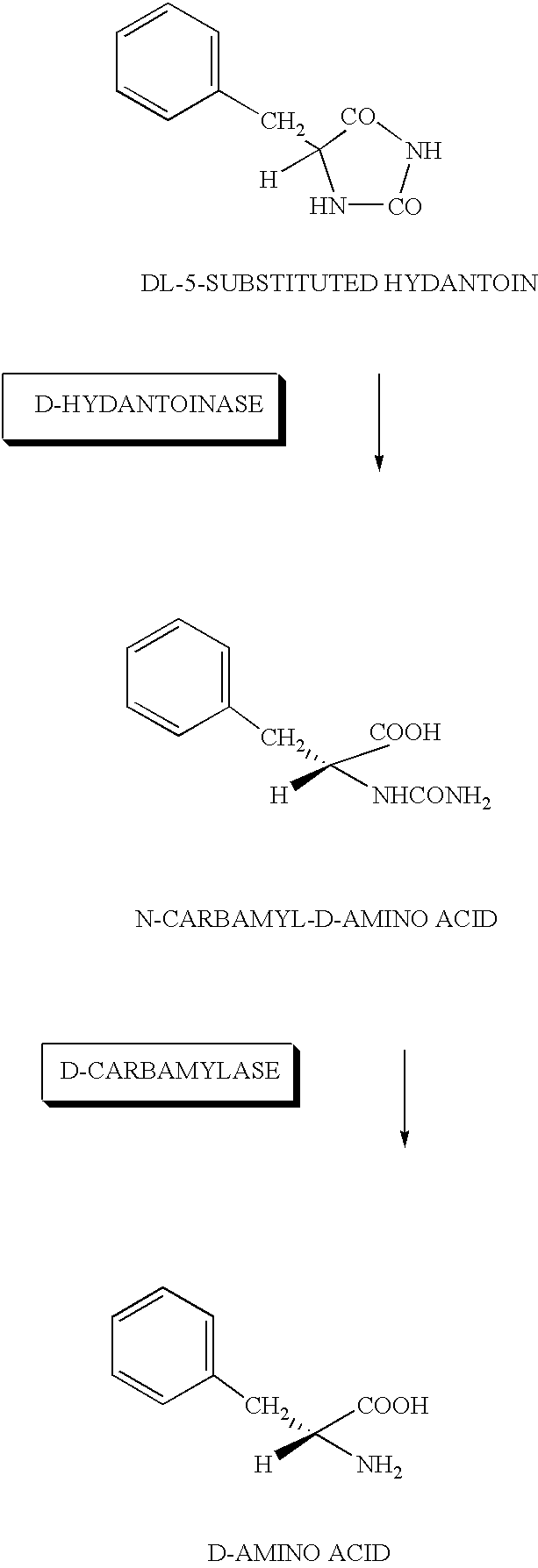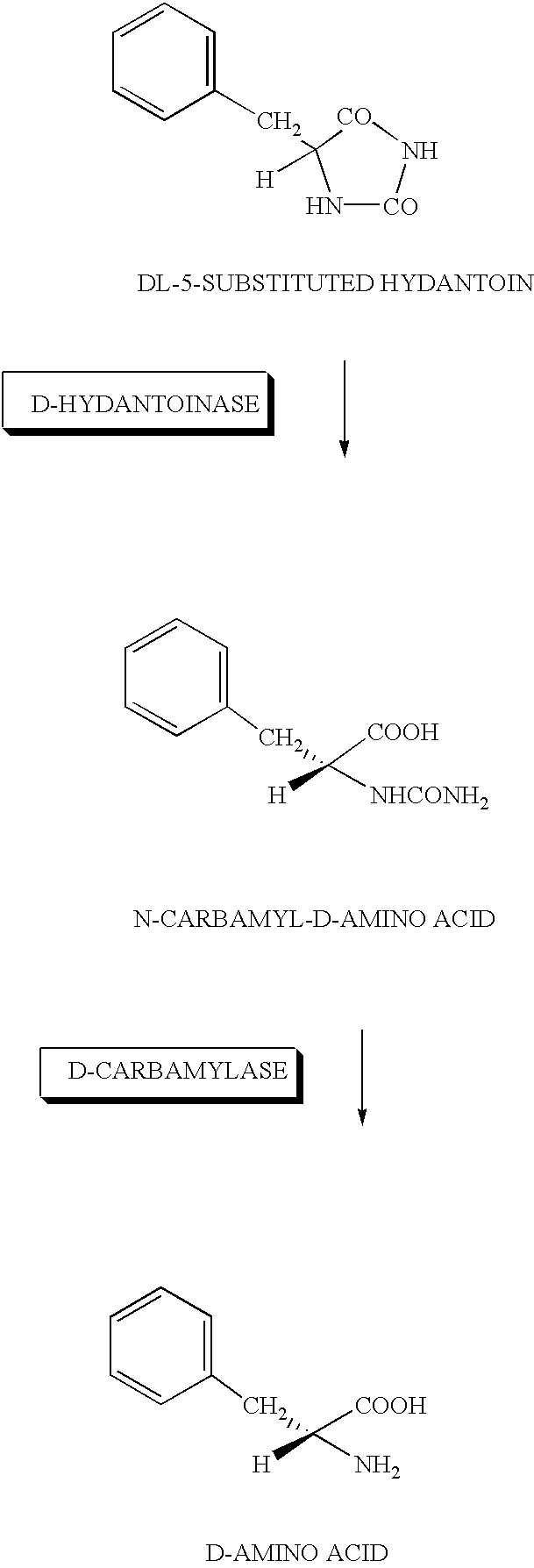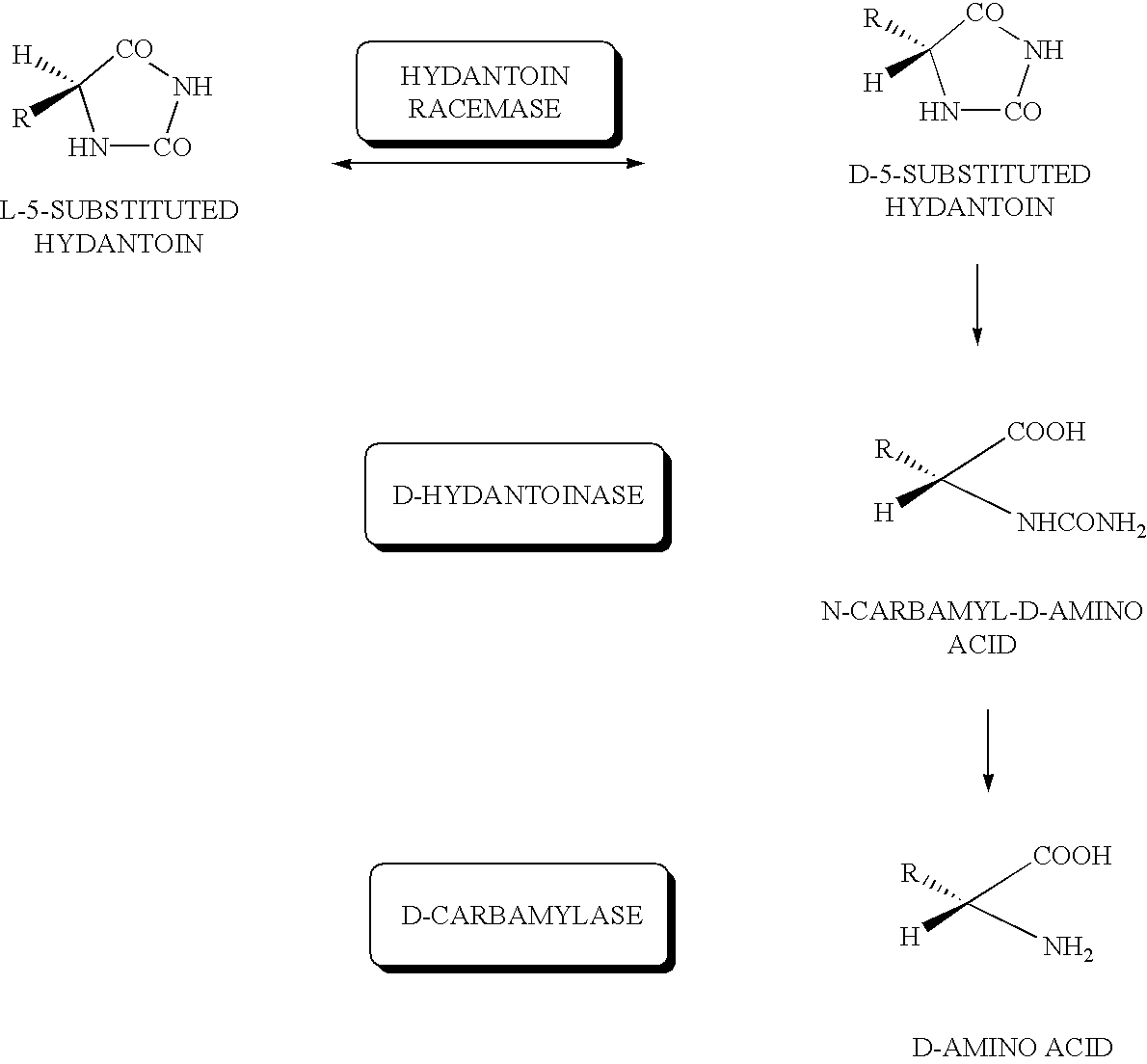DNA for encoding D-hydantoin hydrolases, DNA for encoding N-carbamyl-D-amino acid hydrolases, recombinant DNA containing the genes, cells transformed with the recombinant DNA, methods for producing proteins utilizing the transformed cells and methods for producing D-amino acids
a technology of dhydantoin hydrolase and dna, which is applied in the field of dna for encoding dhydantoin hydrolase, can solve the problems of time-consuming and conventional methods in effecting a reaction, and achieve the effect of enhancing the production of enzymes
- Summary
- Abstract
- Description
- Claims
- Application Information
AI Technical Summary
Benefits of technology
Problems solved by technology
Method used
Image
Examples
example 1
Isolation of D-hydantoinase Gene and D-carbamylase Gene from AJ11221 Microorganism
1. Cell Preparation
[0162]Pasteurella pneumotropica strain AJ11221 was incubated in a CM2G agar medium (glucose 0.5%, yeast extract 1.0%, peptone 1.0%, NaCl 0.5%, Agar 2%, pH 7.0) at 30° C. for 24 hours, whereby being refreshed. One “spatulaful” of the culture medium was inoculated to a 500 mL Sakaguchi flask containing 50 ml of a CM2G liquid medium, which was then incubated aerobically with shaking at 30° C. for 16 hours.
2. Collection of Chromosomal DNA from Cell
[0163]50 ml of the culture medium was centrifuged (12,000×G, 4° C., 15 minutes) and the cell was collected. The cell was then washed by suspending in 10 ml of 50:20 TE (50 mM Tris-HCl, (pH 8.0), 20 mM EDTA) and recovered by centrifugation, and then re-suspended in 10 ml of 50:20 TE. To this suspension, 0.5 ml of a 20 mg / ml lysozyme solution and 1 ml of a 10% SDS solution were added, and the mixture was incubated at 55° C. for 20 minutes. After ...
example 2
Expression of Strain AJ11221-Derived D-hydantoinase Gene and D-carbamylase Gene in E.coli
1. Construction of Expression Plasmid
[0170]In order to express the both genes in E.coli, plasmids pUC413H and pUC413C in which the both genes were ligated to the downstream of the lac promoter of pUC18 were constructed as follows. First, a chromosomal DNA of Pasteurella pneumotropica strain AJ11221 was employed as a template to amplify each gene by a PCR using the oligonucleotides shown in Table 1 as primers. Each of these fragments was digested with XbaI / HindIII and EcoRI / XbaI and ligated to the XbaI / HindIII and EcoRI / XbaI digestion product of pUC18, and then transduced into E.coli JM109. The ampicillin resistant strains were screened for strains having intended plasmids, which were designated as expression plasmids pUC413H and pUC413C.
[0171]
TABLE 1Primers employed for amplifying D-hydantoinase gene andD-carbamylase gene derived from strain AJ11221Hydantoinase5′-endCGCTCTAGAGGGAGACTGACGATGGATC...
example 3
Production of D-phenylalanine Using Washed E.coli Cell
[0178]Washed cells of JM109 / pUC413H and JM109 / pUC413C incubated similarly to Example 2 were prepared, added each at 1 g / dl to 0.1 mM KPB (pH 7.5) containing 1 g / dl of D-5-benzylhydantoin and reacted at 30° C. By sampling at 24 hours after the reaction followed by centrifugation followed by analysis of the supernatant by HPLC, D-phenylalanine produced was quantified.
[0179]The results are shown in Table 3. As evident from this table, by using the washed E.coli cells in which the D-hydantoinase gene and D-carbamylase gene were expressed, D-phenylalanine was produced efficiently from benzylhydantoine.
[0180]
TABLE 3D-Phenylalanine production using washed E. coli cellsD-HydantoinaseD-CarbamylasePhenylalaninegene-expressinggene-expressingproduction levelstrainstrain(g / dl)JM109 / pUC413HJM109 / pUC413C0.31JM109 / pUC18JM109 / pUC180.00
PUM
| Property | Measurement | Unit |
|---|---|---|
| pH | aaaaa | aaaaa |
| temperature | aaaaa | aaaaa |
| temperature | aaaaa | aaaaa |
Abstract
Description
Claims
Application Information
 Login to View More
Login to View More - R&D
- Intellectual Property
- Life Sciences
- Materials
- Tech Scout
- Unparalleled Data Quality
- Higher Quality Content
- 60% Fewer Hallucinations
Browse by: Latest US Patents, China's latest patents, Technical Efficacy Thesaurus, Application Domain, Technology Topic, Popular Technical Reports.
© 2025 PatSnap. All rights reserved.Legal|Privacy policy|Modern Slavery Act Transparency Statement|Sitemap|About US| Contact US: help@patsnap.com



